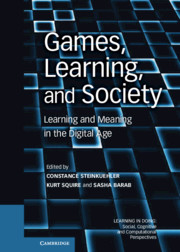Book contents
- Frontmatter
- Contents
- Contributors
- Series Foreword
- Foreword
- Acknowledgments
- Section I Games as Designed Experience
- 1 Introduction to Section I
- 2 Designed Cultures
- 3 Theme Is Not Meaning
- 4 Our Cheatin’ Hearts
- 5 Playing the Odds
- 6 Nurturing Lateral Leaps in Game Design
- 7 Uncharted 2: Among Thieves – How to Become a Hero
- 8 Interview with Harmonix
- 9 Yomi
- Section II Games as Emergent Culture
- Section III Games as Twenty-First-Century Curriculum
- Index
- References
4 - Our Cheatin’ Hearts
Published online by Cambridge University Press: 05 August 2012
- Frontmatter
- Contents
- Contributors
- Series Foreword
- Foreword
- Acknowledgments
- Section I Games as Designed Experience
- 1 Introduction to Section I
- 2 Designed Cultures
- 3 Theme Is Not Meaning
- 4 Our Cheatin’ Hearts
- 5 Playing the Odds
- 6 Nurturing Lateral Leaps in Game Design
- 7 Uncharted 2: Among Thieves – How to Become a Hero
- 8 Interview with Harmonix
- 9 Yomi
- Section II Games as Emergent Culture
- Section III Games as Twenty-First-Century Curriculum
- Index
- References
Summary
The designers of Puzzle Quest have a frustrating burden to bear – everyone thinks they are a bunch of dirty cheaters. The game centers on a competitive version of Bejewelled, in which players duel with an artificial intelligence (AI) to create the most “match-three” colored patterns.
The problem comes from how the pieces on the game board are created – when, for example, a column of three green orbs is lined up and removed from play, new pieces fall in to take their place. However, sometimes, these three new pieces happen to be of all the same type, which means that a new match is made automatically, and the player scores again. The odds of such a result are low (around 2 percent for getting three of the same colors in a row), but they are still high enough that a player will see it many times with enough games played.
Of course, the AI is playing the same game, so the player will see this lucky match fall into the enemy’s lap as well. At this point, human psychology takes over. Because the new pieces are hidden from view, how does the player know that the computer is not conducting some funny business and giving itself some free matches?
The human mind is notoriously bad at grasping probability, so many players are convinced that the AI is cheating. The developers have pledged over and over again that everything is fair and even, but whether they like it or not, the player experience has been affected by the simply possibility of cheating.
- Type
- Chapter
- Information
- Games, Learning, and SocietyLearning and Meaning in the Digital Age, pp. 40 - 43Publisher: Cambridge University PressPrint publication year: 2012



